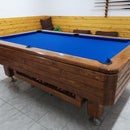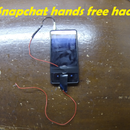Introduction: Chocolate, the Physical Side
The aim of this study is to find the lowest temperature at which chocolate can be in a liquid and the highest temperature at which it can be in a liquid state. I have also investigated the properties of chocolate like melting point and solidification temperature, energy required to heat the chocolate to a certain temperature, the viscosity at a given temperature, also I researched hysteresis loop in the melting and solidification.
You'll see the difference in measurements as far as instruments, the reason for that is that I was doing part of the measurements at home with the "primitive technology" and the other part in a lab.
If you will like it, feel free to vote!
Step 1: Introduction:
At first, lets say something about chocolate composition. Usually it is made of: cocoa butter, cocoa sugar, milk powder. Melting point is usually somewhere between 30°C and 36°C.
Proportion of each of the ingredients can greatly change the physical characteristics and properties of chocolate. I have considered the ways in which different chocolate manufacturers may change the measurement results and decided that I would use my own chocolate that does not contain any excipients. In the beginning, I'll have to decide how to define when the chocolate is in liquid form. I decided it to be when the droplet fall from chocolate sample.
Main questions are:
1. What is happening with viscosity when changing the temperature of chocolate?
2. Can chocolate be both in liquid and solid state by room temperature?
3. Will graph of heating and heat transfer have similar form/curve?
My hypothesis are:
1. Chocolate will have greater viscosity when cooling, but lower when heating.
2 No, chocolate can not stay in liquid state by room temperature because it melts on about 32°C
3. Graph of heat transfer to the chocolate should be very similar to the graph of heating.
Step 2: Making the Calorimeter
Accessories:
styrofoam, empty can, scissors, knife, rubber tube, a thermometer, a battery (or power supply) wire, a multimeter (or anything else that would show that the circuit is closed), metal plates, duct tape (purpose: keeping the discs in the air), plastic bags, two cooking rings, hair drier
For most precise measurements I needed some calorimeter, so I made one. In picture is shown the process of making it.
In case someone doesn't know what calorimeter is. Generally, calorimeter is well isolated bowl which prevents any heat loses of material which is inside of it.
Droplet test theory:
there is plate slightly over two parallel wires,when droplet drop, plate connect those 2 wires and then the current is flowing.
Step 3: Calorimeter Calibration
After I made it, I had to calculate my heat loses so that later I could do more precise measurements.
The technique was that I poured hot water into the pan and wait for the temperature ceases to fall, then according to this difference, I calculated heat transfer following this equations:
Q_taken= Q_given
C_calorimeter* ∆T1 = C_water * ∆T2
C_calorimeter = C_water * m_water ((t_initially– τ) / (τ –t_initial)) t_finally – temperature of hot water
c_water = 4190 J*kg-1*K-1
τ – water temperature after equalization
t_initially – temperature of cold/normal water.
C_calorimeter=47.2 J/K
Second picture shows measurement results.
Step 4: First Test Melting of Bought Chocolate
To see exactly how chocolate behaves at different temperatures, I made several experimental measurement. The first measurement was carried out with chocolate for cooking on a metal surface above the burner. After the entire sample melted, I put it in the fridge for half an hour. When I pulled out of the fridge, chocolate was still liquid, but after 45 minutes where hardened. The second measurement I've repeated four times. I put the sample every time on radiator heated to 40 ° C and then in freezing point on -15 ° C, for 20 minutes. Every time after having order it took was solid, but every time it was all disorganized condition and should make her less time and lower temperature to be melt again. And each time to on surface were more round crystals.
Step 5: Cocking My Chocolate
Ingredients:
cocoa butter 50g
sugar 25g
milk powder 25g
cocoa 100 g
Accessories:
scale, thermometer, stirrer, metal container, heat source
Proportion of cocoa was 50%.
Process:
First I melted cocoa butter and sugar, and cocoa added at the end of the milk powder. Before placing in container, every ingredient I weighed after adding stir well. I did not have a continuous, controlled heat source, so it was necessary to use a thermometer and gently and slowly to warm up, because if the temperature exceeds 40 ° C or let the temperature drops to about 25 ° C chocolate would not be a desired quality. The procedure lasted about an hour, without cooling.
Step 6: Molds:
I used molds to have exact samples every time, that way I get most precise measurements. As material I used clay.
When the chocolate was ready, I poured it into a mold coated with plastic kitchen wrap, in center of mold I put thermometer, then I left chocolate hardens.
Step 7: Heating Process:
I measured the temperature of chocolate and its dependence on time when heating a sample of chocolate.
Picture shows measurement data. T1 is first heating, T2 is second time heating. The graph isn't like I expected, I'll do more precise experiments later.
As melting point of my chocolate, it turns out to be 35 C.
Step 8: And Now Some Lab Measurement Results:
Measurement apparatus are in pictures, I had to make my own rotary viscometer (I will explain later how does it work).
Software in which I worked is LoggerPro, great program, it has everything what you need for physics and other stuff where you need to make some graph and fit a function in it, you can also measure the speed of moving object with video.
Step 9: Theory of Viscosity
Viscosity is defined as the resistance to flow. Imagine two plates (as in sketch) of area A, between which is fluid, (thickness y) which is due to adhesion (adhesion-occurrence of binding of different materials to one another when they come into contact with each other) and the frictional force "sticks" it to the surface plate. Fluid between the plates can be divided into several layers. If one of the plates we start to move with speed v in x direction, then the layer of fluid closest to panel also move with speed v in direction X.
We conclude that the force F needed to move the plates is proportional to its area A (larger surface area = more force required to move due to the greater amount of fluid that moves along with the board), is proportional to the speed which is inversely proportional to the distance between the plates y (y = multiple layers of fluid = more force required to move all the layers).
From that we get equation:
F=η(A*v/y)
Where is:
F-force acting to plate
η-viscosity coefficient
A- surface plate v-velocity of plates
Also, there is a shear stress and shear rate in the chocolate. The equation for the shear stress (τ): τ=F/A
Step 10: Measuring the Viscosity of Chocolate:
In sketch is shown viscometer. The outer container is rotated together with the chocolate, and the container within the bigger container is less surface of area A. The torque is transmitted through the chocolate to the inner container, lever shaft (K) is connected to a dynamometer which measures the force on arm so you can get a torque in relation to the rotation speed of the outer container. Original picture of viscosimeter is on beginning of this instructable.
Equation for viscosity (η)looks like that:
η=(yF)/(Av)
About fluids, we separate them by next categories:
Pseudoplastic fluids: color, lava, ketchup, blood, cream
A non-Newtonian fluids: chocolate, a mixture of cornstarch and water, etc.
Newtonian fluids: water, air
And about chocolate, in further measurements I used the one which I bought because I ate last one which I cocked, and I was to lazy to make another.
Step 11: Viscosity Results
Graph shows results which I get from my measurement, the process was next:
I have made measurements on a way that in container which measured viscosity is placed chocolate at 60 ° C and cooled to 20 ° C, after the fall of the temperature for every 10 ° C I take a note . From the graph it can be seen that after about 40 ° C the viscosity begins to increase exponentially, it is most likely going to form some kind of quasicrystals peculiar to provide different physical properties, similar to what happens with sulfur, when it crosses below 20 ° C the viscosity also begins to increase as the chocolate solidifies.
Step 12: About Calorimeter Which I Used
Sketch just shows how my lab calorimeter is made. Of course, I had to to calculations like from the one earlier, I used same principle and I get :
C_calorimeter= 108 J/K.
Step 13: Heating:
-The curve in the graph we can see that the graph consists of three parts.
At the start of heating, the temperature increases linearly, then has step change and is followed by a rise in temperature, which is manifested as a parable. As an explanation of the phase shift (about 28 ° C)I would said that chocolate in this area goes in liquid state, that is, it can be said that softens, it is called a hysteresis loop. Tearing the connection between the chain and finally the links in the chains. Chocolate in graph softens about 28 ° C and melts at around 33 ° C. • I made measurement in a way that I put a certain amount of chocolate in a glass cup first and then all together in a hot bath which was located in the calorimeter with a thermometer in the chocolate, and then I waited for the temperature starts to rise.
Step 14: Cooling
The graph shows the cooling of chocolate. The graph also consists of three parts, the first part of the graph clearly shows that the temperature decreases exponentially, and then on the end of the line change its angle that goes further. Temperature is falling slower, the middle part of the graph, is the hysteresis during cooling down. Melting point depends on the cooling rate, the reason is the crystallization of the crystals in the chocolate. If the chocolate cools faster melting point will increases and vice versa, it can be said that chocolate remembers what previously happened to her.
In all those graphs I fitted functions to prove that it is/it is on linear.
Step 15: Comparison
The graph shows the heating and cooling of chocolate so you can clearly see the difference in the temperature range where the chocolate is still liquid. I made measurements in a way that I put 12g of chocolate in boiling water, then into cold water.
Step 16: Determination of the Energy Given to Chocolate in Relation to Temperature:
A graph is showing the relation between the heat that chocolate is received compared to its temperature. I made measurements in a way that I put chocolate in the calorimeter with thermometer and heater, through heater I let current at certain time so that I got the heat transfer, then I theoretically calculate how much water temperature should raise and then compared with the results obtained by practically. The deviation of the theoretical and practical results is the amount of heat that is handed system, and since we know calorimeter's heat capacity,we only ad this amount to water and the rest is transferred to the chocolate. I worked with 0.04 kg of chocolate.
The way how did I calculate that is in second picture, it is screenshot from Word, there are nicer equations :)
Step 17: Conclusion:
From the measurements, I learned that the chocolate does not melt at the same temperature as well as on which solidifies. We conclude that chocolate viscosity increases exponentially with decreasing temperature as well as at temperatures above 40 ° C, the melting point and freezing point are not nearly the same if you compare the graph of heating and cooling chocolate, melting point changes with respect to the cooling rate.
About hypothesis which I mention on beginning:
1. Half-true, chocolate has lower viscosity until it reaches specific temperature, then it began to rise again
2. Wrong, chocolate can be both in solid and liquid state by room temperature
3.Yes, graph of heating the chocolate and energy/heat transfer to chocolate are quite similar
Thanks for reading! Sorry for grammar mistakes!
You can also view some of mine other projects if you liked that one. :D

Third Prize in the
Data Visualization Contest

Participated in the
Scientific Method Contest

Participated in the
Full Spectrum Laser Contest













